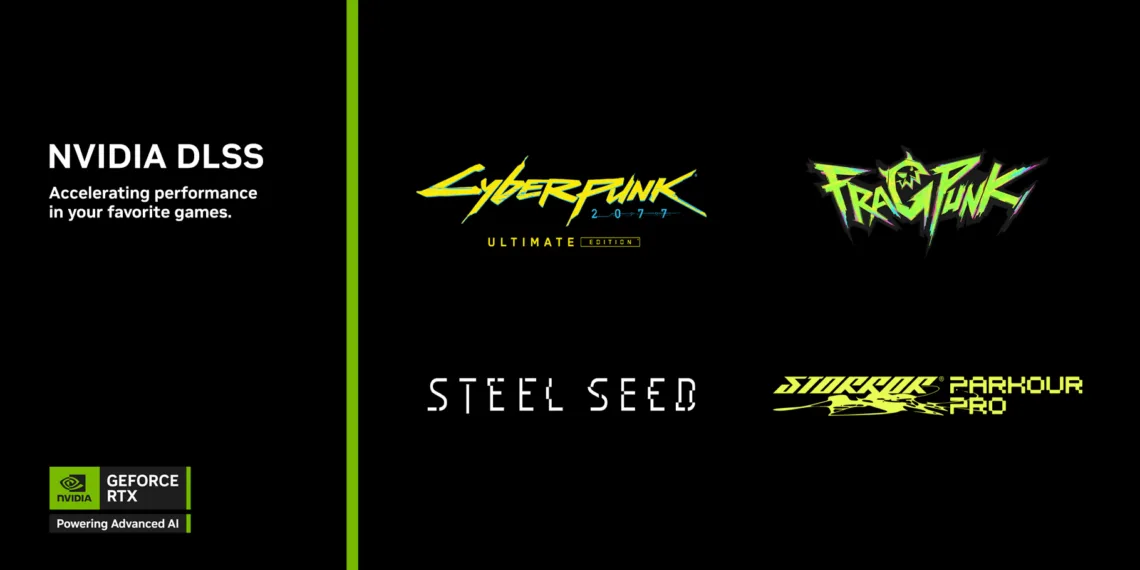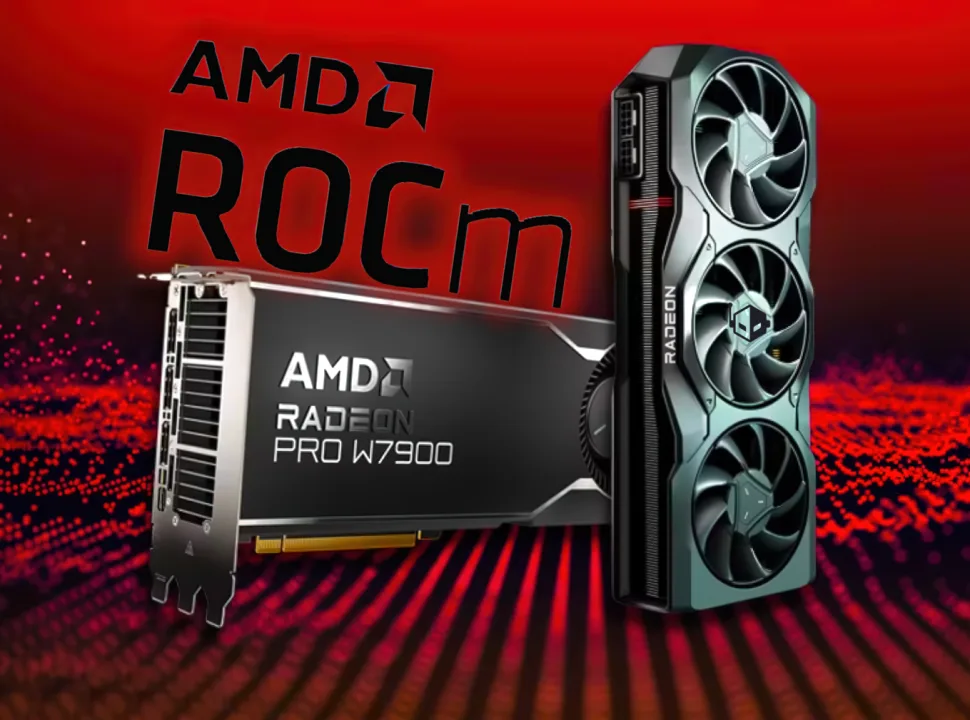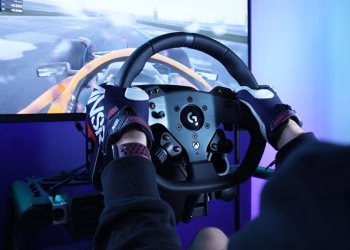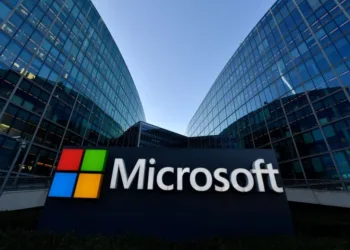NVIDIA DLSS 4: In the ever-evolving world of PC gaming, few technological advancements have made as significant an impact as NVIDIA’s Deep Learning Super Sampling (DLSS). Now, with the arrival of NVIDIA DLSS 4, gamers are witnessing what might be the most impressive leap forward in AI-powered gaming technology to date. This revolutionary technology is changing how games render graphics, delivering unprecedented performance boosts while maintaining—and in many cases enhancing—visual quality.
Table of Contents
What Makes NVIDIA DLSS 4 a Game-Changer for PC Gaming
NVIDIA DLSS 4 represents the fourth generation of NVIDIA’s AI-powered upscaling technology, but this isn’t just an incremental update. The introduction of Multi Frame Generation technology fundamentally changes the equation, allowing compatible systems to generate multiple AI-created frames for each traditionally rendered frame. This breakthrough approach to frame generation is why it can deliver up to 9X performance improvements on RTX 50 Series hardware—a figure that would have seemed impossible just a few years ago.
“DLSS 4 introduces Multi Frame Generation technology that can generate up to three additional frames for each rendered frame,” explains an NVIDIA engineer. “This means your GPU only needs to render a fraction of the frames you see on screen, with AI handling the rest.”
For gamers, this translates to smoother gameplay, higher frame rates, and the ability to play demanding titles at higher resolutions and quality settings than ever before. But to truly understand why DLSS 4 matters, we need to look at the technology behind it.
The Technology Behind NVIDIA DLSS 4 Features
The most impressive spec is that it features include Multi Frame Generation and enhanced image quality through transformer AI models. At its core, DLSS has always used AI to upscale lower-resolution images to higher resolutions, but DLSS 4 takes this concept much further.
Multi Frame Generation Explained
Multi Frame Generation is the cornerstone of DLSS 4’s impressive performance improvements. Unlike previous versions that generated one additional frame, it can create up to three AI-generated frames for each traditionally rendered frame. This means your GPU only needs to render one out of every four frames you see, dramatically reducing the rendering workload.
The technology works by:
- Analyzing the current frame and previous frames
- Predicting motion vectors to determine how objects will move
- Generating intermediate frames with high accuracy
- Applying advanced anti-aliasing and image enhancement
This process happens in milliseconds, resulting in gameplay that feels responsive despite the heavy use of AI-generated frames.
Advanced Transformer AI Models
DLSS 4 employs a sophisticated transformer AI model that brings several technological improvements over previous versions:
- Vision Transformer Architecture for comprehensive frame analysis
- Enhanced temporal stability for more consistent image quality
- Improved detail preservation in motion
- Reduced ghosting artifacts that plagued earlier versions
- Better ray-traced element reconstruction
“The transformer AI model in DLSS 4 significantly improves image quality compared to previous versions,” notes a technical reviewer. “It’s particularly noticeable in scenes with complex lighting or fast motion.”
DLSS 4 vs DLSS 3: What’s Actually Improved?
When comparing DLSS 4 vs DLSS 3, several key improvements become apparent:
Image Quality Enhancements
- Superior texture quality, especially in distant objects
- Reduced temporal motion blur during camera movement
- Enhanced anti-aliasing with fewer jagged edges
- Improved ray-traced elements with better light reconstruction
Technical Advancements
- Up to 30% reduction in memory usage
- Enhanced ray tracing clarity in complex scenes
- Significantly reduced visual artifacts in motion
- Improved frame generation pipeline with lower latency
These improvements make DLSS 4 not just a performance enhancement but also a visual quality upgrade in many scenarios.
NVIDIA DLSS 4 Game Implementations: Current and Upcoming Titles
Games that support DLSS 4 can see performance improvements of up to 9X on compatible hardware. Let’s look at some of the titles currently implementing this technology:
Steel Seed
Storm in a Teacup and ESDigital Games’ Steel Seed is a stealth-action adventure set in a dark sci-fi world where humanity stands on the brink of extinction. When Steel Seed launches on April 22nd, it will offer tiered DLSS support:
- GeForce RTX 50 Series: Full DLSS 4 with Multi Frame Generation
- GeForce RTX 40 Series: DLSS Frame Generation (DLSS 3)
- All RTX GPUs: DLSS Super Resolution
This tiered approach ensures that all RTX owners get performance benefits, with the latest hardware delivering the best experience. Steam users can already download a DLSS Super Resolution-enhanced demo to get a taste of what’s coming.
STORROR Parkour Pro
Hole in the Sleeve Game Studios’ new multiplayer parkour experience has just launched into Early Access with comprehensive RTX technology support:
- DLSS Frame Generation for RTX 40 Series owners
- DLSS Super Resolution for all RTX users
- Hardware-accelerated Lumen ray-traced lighting
- NVIDIA DLAA for maximum image quality
The implementation in STORROR Parkour Pro showcases how DLSS can be combined with other RTX technologies to deliver both performance and visual enhancements.
Cyberpunk 2077 & FragPunk
The latest NVIDIA DLSS update brings support to several highly anticipated game titles, including the popular Cyberpunk 2077 and FragPunk. Both games now feature:
- Full DLSS 4 with Multi Frame Generation
- Latest transformer AI models for enhanced image quality
- Up to 9X performance multiplier on RTX 50 Series hardware
CD Projekt RED’s implementation in Cyberpunk 2077 is particularly impressive, allowing players to experience Night City with ray tracing at high frame rates even at 4K resolution.
Hardware Requirements: What You Need for NVIDIA DLSS 4
For those wondering how to enable DLSS 4, you’ll first need compatible hardware and the latest drivers. The technology has specific hardware requirements:
RTX 50 Series Integration
DLSS 4 with Multi Frame Generation requires an RTX 50 Series GPU, as it relies on:
- Fifth-generation Tensor Cores
- Fourth-generation Ray Tracing Cores
- Blackwell architecture support
- Neural shader optimization
Tiered Support for Different Hardware
While DLSS 4 with Multi Frame Generation is exclusive to RTX 50 Series, other DLSS features are available to older hardware:
- RTX 40 Series: DLSS 3 with Frame Generation
- All RTX GPUs: DLSS Super Resolution
- RTX 20/30 Series: DLSS 2 features
This ensures that even if you don’t have the latest hardware, you can still benefit from NVIDIA’s AI upscaling technology.
How to Enable DLSS in Supported Games
Learning how to enable DLSS 4 in supported games is straightforward through the graphics settings menu. The process typically involves:
- Ensure you have the latest NVIDIA drivers installed
- Launch a supported game
- Navigate to the graphics or display settings
- Look for the DLSS option (usually under “Advanced Settings”)
- Select DLSS and choose your preferred quality mode
- Enable Multi Frame Generation if available
Most games offer several quality modes for DLSS, including Quality, Balanced, Performance, and Ultra Performance. The right choice depends on your hardware and desired frame rate.
Real-World Performance: What Gamers Can Expect
The performance improvements offered by NVIDIA DLSS 4 are most noticeable in graphically demanding titles. Based on testing across multiple games:
- At 4K resolution with ray tracing: 2-3x higher frame rates
- At 1440p with high settings: 1.5-2x higher frame rates
- At 1080p with maximum settings: 1.3-1.8x higher frame rates
These improvements are most dramatic in games that are GPU-bound, particularly those with ray tracing enabled. For example, Cyberpunk 2077 with full ray tracing at 4K resolution can go from barely playable to smooth 60+ FPS experiences with DLSS 4 enabled.
“Make sure to install the most recent NVIDIA DLSS 4 update to get the best performance in supported games,” advises a technical expert. “Each update typically improves compatibility and performance.”
The Future of DLSS and AI in Gaming
NVIDIA DLSS 4 represents just the beginning of what’s possible with AI in gaming. As developers become more familiar with the technology, we can expect:
- More widespread adoption across major titles
- Better integration with game engines
- Further refinements to image quality
- Expanded applications beyond just frame rate improvements
Developers are rapidly implementing NVIDIA DLSS 4 features in their latest game releases, and this trend is likely to accelerate as more games are built with the technology in mind from the ground up.
Is DLSS 4 Worth the Upgrade?
Gamers looking to maximize their experience should consider upgrading to hardware that supports NVIDIA DLSS 4, but the decision depends on several factors:
- Your current hardware and its performance in games you play
- Whether you play (or plan to play) DLSS 4-supported titles
- Your budget for hardware upgrades
- Your sensitivity to frame rates and image quality
For those playing demanding modern titles, particularly with ray tracing enabled, the performance improvements from DLSS 4 can be substantial enough to justify an upgrade. However, if you’re primarily playing less demanding games or titles without DLSS support, the benefits may be less noticeable.
Understanding the NVIDIA DLSS 4 features can help you decide if upgrading your hardware is worthwhile. For many gamers, especially those looking to play at 4K resolution or with ray tracing enabled, the answer will increasingly be “yes” as more games add support.
Conclusion: The New Standard for PC Gaming Performance
NVIDIA DLSS 4 represents the most significant leap forward in AI-powered gaming technology to date. By fundamentally changing how frames are generated, it delivers performance improvements that would have been impossible through traditional rendering methods alone.
As more games implement support for DLSS 4 with Multi Frame Generation, this technology is poised to become the new standard for high-performance PC gaming. For players with compatible hardware, it offers the best of both worlds: dramatically improved performance without sacrificing—and in many cases while enhancing—visual quality.
Whether you’re exploring the dystopian world of Steel Seed, performing parkour stunts in STORROR Parkour Pro, or revisiting Night City in Cyberpunk 2077, DLSS 4 ensures you’ll experience these worlds with unprecedented smoothness and visual fidelity. The future of gaming is here, and it’s being rendered one AI-generated frame at a time.








